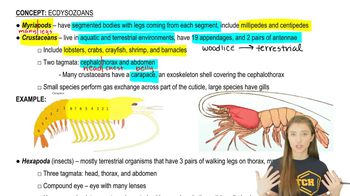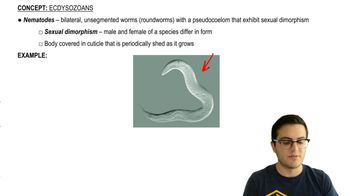31. Invertebrates
Ecdysozoans
Learn with other creators
Practice this topic
- Multiple ChoiceThe arthropods superficially resemble earthworms in that both groups __________, yet the two are distinctly different because arthropods, but not earthworms, __________.964views
- Multiple ChoiceA major characteristic of arthropods is __________.1721views
- Multiple ChoiceIn most insects, gas exchange is accomplished by __________.1099views
- Multiple ChoiceIn arthropods, molting is necessary because __________.1314views
- Textbook Question
Which phylum is characterized by animals that have a segmented body?
a. Cnidaria
b. Platyhelminthes
c. Arthropoda
d. Mollusca
1473views - Textbook Question
What is the function of the arthropod exoskeleton?
a. The presence of an exoskeleton has given arthropods a good fossil record, because hard parts fossilize more readily than do soft tissues.
b. It has no well-established function. (Trilobites had an exoskeleton, and they went extinct.)
c. It provides protection and functions in locomotion.
d. It makes growth by molting possible.
1547views - Textbook Question
Why is the pea wrinkle-seed allele a recessive allele?
a. It 'recedes' in the F2 generation when homozygous parents are crossed.
b. The trait associated with the allele is not exhibited in heterozygotes.
c. Individuals with the allele have lower fitness than that of individuals with the dominant allele.
d. The allele is less common than the dominant allele. (The wrinkled allele is a rare mutant.)
941views - Textbook Question
The alleles found in haploid organisms cannot be dominant or recessive. Why?
a. Dominance and recessiveness describe which of two possible phenotypes are exhibited when two different alleles occur in the same individual.
b. Because only one allele is present, alleles in haploid organisms are always dominant.
c. Alleles in haploid individuals are transmitted like mitochondrial DNA or chloroplast DNA.
d. Most haploid individuals are bacteria, and bacterial genetics is completely different from eukaryotic genetics.
1495views











